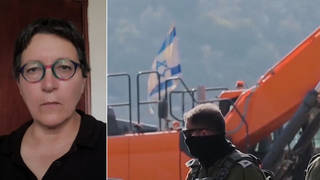
Concerns are being raised about the hazards posed by thousands of abandoned oil and gas wells throughout the Gulf Coast. An Associated Press investigation found more than 27,000 abandoned sites are in danger of leaking, with about 13 percent said to be particularly worrisome. Regulations forcing companies to plug the wells have been routinely ignored with no government intervention. We speak with Jeff Donn, the AP reporter who broke the story. [includes rush transcript]
Transcript
JUAN GONZALEZ: Leading environmental groups and a US senator are calling on the government to pay closer attention to more than 27,000 abandoned oil and gas wells in the Gulf of Mexico and take action to prevent them from leaking even more crude following the BP disaster. The calls for action follow an Associated Press investigation that found federal regulators do not typically inspect the plugging of offshore wells or monitor for leaks years afterward. The AP uncovered particular concern with 3,500 of the neglected wells. Regulations forcing companies to plug the wells have been routinely ignored with no government intervention. The well beneath the Deepwater Horizon was being sealed for temporary abandonment when the rig explosion that caused the disaster occurred. Overall, BP has abandoned about 600 wells.
AMY GOODMAN: Democratic Senator Mark Udall of Colorado sent a letter to Interior Secretary Ken Salazar Wednesday asking him whether the department agrees with AP’s findings. Udall wrote, quote “We can’t afford the leak that’s now occurring. We certainly couldn’t afford additional leaks in the future.”
Jeff Donn is the AP reporter who co-wrote the story. He’s a member of the Associated Press’s national investigative team. He’s joining us from Boston.
We welcome you to Democracy Now!, Jeff. Just lay out what you found.
JEFF DONN: We found that there are about 27,000 abandoned wells in the Gulf of Mexico on federal lease lands underneath the Gulf. And that’s more than half of the 50,000 or so oil and gas wells that have ever been drilled in the Gulf of Mexico. So there are a lot of wells out there. And we found out that, on land, oil and gas wells that have been abandoned do frequently leak, even when they’ve been plugged correctly, and not just the ancient ones, but even wells that have been abandoned in recent decades. And we also found out that there have indeed been leaks at offshore wells that have been abandoned in both state waters, and the federal regulators finally acknowledged even some in the federal waters that are a little farther out.
JUAN GONZALEZ: And Jeff, what’s the difference that you highlight between the temporarily abandoned and the permanently abandoned wells? And what are the federal requirements, if any, to monitor the two types?
JEFF DONN: Well, it’s interesting. The companies that drill in the Gulf temporarily abandon wells — this is a status that the federal government grants — when they are done drilling for a time, when there’s perhaps a problem with the well or they want to reassess the well or they want to wait 'til the price of oil or gas gets higher. So they're allowed to temporarily abandon a well. We found about 3,500 of those wells in the Gulf. And they’re supposed to undergo annual reviews. Within a year, the owner of the well is supposed to come back to the federal government and say, “Hey, we plan to reuse the well in this way,” or, “You know what, we plan to permanently abandon it.” And part of the problem there is that we found wells in that temporary status for decades, since the 1950s and 1960s. And that means they don’t have quite the level of safeguards that the permanently abandoned wells are supposed to have. They’re not cut off all the way at the bottom of the sea floor. They don’t tend to have as many of these cement plugs that prevent oil or gas from coming up the wells. So they’re allowed to remain in that temporary status for decades.
The rules are basically — I wouldn’t say that they’re — the rules are flatly ignored. I would say that the rules don’t really have any teeth. The companies that abandon wells submit paperwork. Federal regulators simply accept that paperwork, accept that the job is done. They do not routinely come and inspect the work, as they do in some states. And then after the well is abandoned, nobody goes back. Neither the industry nor the government goes back and checks on whether these wells are leaking. And yet, we know from experience with wells elsewhere that abandoned wells, a certain number of them, will eventually leak. And we know from the Deepwater Horizon, which was in the midst of a temporary abandonment job, we know that those kinds of sealing jobs can fail.
AMY GOODMAN: Jeff Donn, can you explain what you just said? I don’t think most people understand that, that it was in the midst of a temporary abandonment.
JEFF DONN: Yeah, I think you’re right. I don’t think most people understand that. BP had been drilling a well there to look for oil, and the reports are that they had found what they were looking for, that they had found oil. And they’ve been clear that they were — had just pumped in cement to create one of these plugs that’s supposed to temporarily seal the well, so that they could leave the well for a time — nobody said exactly how long — and then come back when they were ready to produce with the well. And they can actually drill back through these cement plugs and get at the hydrocarbons underneath. So they were temporarily abandoning the well. And we found the paperwork showing that they intended for the well to enter into that kind of limbo status, where — that some wells have had for decades now.
JUAN GONZALEZ: And Jeff, your report also indicates that the federal government has been warned for the better part of two decades now. There was a GAO report back in 1989 warning of potential problems and possibly even disasters from these plugged wells?
JEFF DONN: Yeah, that’s right. I think that report was in 1994. And the GAO — that’s, of course, Congress’s investigative arm — warned that these abandoned wells could pose a serious environmental problem. It even used the phrase “environmental disaster.” And it said the federal government ought to come up with some reasonable program of inspecting these kinds of wells. It never happened. We found records of the EPA saying that, on land, these kinds of wells pose a significant threat to the environment, even when they’ve been fully depleted, because, people should understand that, even when a well that was used for production and it no longer is producing anything in paying quantities, it can become reenergized, repressurized again, sometimes from the aquifers that are underneath that push upward, sometimes from work on other wells nearby. So, these wells always have the potential to produce pressure again. And the danger, of course, is that these gas or — the gas or the oil underneath the sea floor then can push up through spaces in the well and escape into the ocean. Of course, the oil and gas are toxic. They’re not supposed to be in the ocean, and they can affect the aquatic species in the oceans.
JUAN GONZALEZ: And what kind of personnel did MMS, the agency in charge of this, have devoted to monitoring these wells?
JEFF DONN: Ask your question again. I’m not sure I got the sense of it. I apologize.
JUAN GONZALEZ: What kind of personnel did MMS, the agency that was supposedly in charge of — you know, of offshore drilling, have to monitor these plugged wells?
JEFF DONN: Well, MMS, they’re the new Bureau of Ocean Energy Management Enforcement — Regulation and Enforcement. That’s their new name, where their safety functions have been peeled off to this new agency. They have really very limited personnel. They have some scores of people who are available for inspections in the Gulf. But remember, we’re talking about thousands and thousands of active wells, either — in some stage of drilling, typically, in the Gulf. So, they really — common sense tells you that they have serious constraints on what they can look at. And they’ve chosen to focus on the wells that are active. It’s not clear that they have the resources even to look at the abandoned wells. And I think that was part of what Senator Udall was getting at in his letter to Ken Salazar. Udall is a member of the Energy Committee. Salazar is a fellow Coloradoan, like Senator Udall. And I think that’s part of what Udall was getting at when he said, “Do you need some kinds of additional tools to keep these abandoned wells safe?”
AMY GOODMAN: This has provoked outrage among many leading environmental groups calling on some kind of regulation. Melanie Duchin, you quote, a spokeswoman for Greenpeace, said she was shell-shocked by the AP report, upset the government isn’t doing a thing to make sure they weren’t leaking. Jeff Donn, what do you think has to be done first right now? I mean, this is quite remarkable to talk about tens of thousands of abandoned wells in the Gulf of Mexico.
JEFF DONN: Well, I think part of what happened is this was a significant problem that was way off everybody’s radar. The industry and the government just acted like it was a problem that didn’t exist. These wells are gone and forgotten. A federal petroleum engineer told me they’re not supposed to leak. So, it was something that people weren’t paying attention to. Even people in the industry were surprised to realize that there were so many abandoned wells out there. I think what Udall is driving at, what people will begin to think about, is whether there might be some value for starters, at least, at least as a first step, to consider maybe whether there should be inspections of at least some of these well sealing jobs as the companies get ready to abandon them. We know that it can be done in a practical way. California, for example, does it, and they make a special effort to inspect the wells that are being abandoned offshore, because they know that if anybody has to come back to an offshore well, it’s going to be harder and more expensive. Some of these offshore jobs in the deep wells, they can be thousands of feet deep. Some of them can cost millions of dollars just to abandon the well. And part of the problem is that can’t be a profit center for the companies.
JUAN GONZALEZ: Jeff, one final question. I’m shocked by the number here, that you have 50,000 wells over six years have been drilled in the Gulf? You’re talking about 8,000 a year. That’s about twenty-five wells per day for the last sixty years have been drilled in the Gulf of Mexico?
JEFF DONN: That’s right. It started off, of course, a little bit more slowly, and the curve kind of went upward. But there has been a tremendous amount of drilling. It started in the 1940s, and it’s increased ever since. There has been more water in — more drilling in deeper water, thousand feet deep, that kind of depth, even deeper than that, in recent years, and that’s picking up. And part of the problem with that, in this context is that it’s just harder to get at the wells to abandon them when they’re that deep. It can be done, it just takes a little bit more time and money to make sure that it’s done right, so that’s part of the concern as well, that some of these more recent wells that are now being abandoned are going to take more effort to seal properly.
AMY GOODMAN: Jeff Donn, we want to thank you for being with us, national writer for AP, member of the AP’s National Investigative Unit that has reported this piece, “Gulf Awash in 27,000 Abandoned Wells,” We’ll link to it at democracynow.org. This is Democracy Now! Back in a minute.
[break]
AMY GOODMAN: “Crossroad Blues,” Robert Johnson, here on Democracy Now!, democracynow.org, the War and Peace Report. I’m Amy Goodman, with Juan Gonzalez.
JUAN GONZALEZ: Well, before we go on to our next story, I want to make a correction on my math over that last segment. That was about 8,000 every ten years in the number of wells being drilled in the Gulf. It comes out to about three wells a day, not twenty-five.
AMY GOODMAN: Still a remarkable number in the Gulf of Mexico.
JUAN GONZALEZ: Still an enormous number for that long a period of time.
AMY GOODMAN: Well, let’s continue on the issue of oil.












Media Options